QuestionWe are caring for a male bermise (?) phython and would appreciate some info. on aquarium temperature, humidity, etc. He had been put outside in the Feb. weather and there was no-one else that would take him. I couldn't stand to see him not cared for. Someone had stolen his heat lamp so we did buy a heat lamp bulb that we put on top of his cage. We have had him since Sunday and are trying to keep his cage (glass) around 70-75 degrees with around 50% humidity, but we are doing good to keep it at 45%. He is a rather young snake (around 6-8 months). He is about 4' length and the biggest part of his body is about 3" round (girth). He is a beautiful snake. I do not know anything about snakes except what I have seen on nature or the emergency vet shows. He has been staying curled up in his water bowl most of the time. I wasn't sure if that was because it wasn't humid enough or warm enough or if it was normal. I want to keep him healthy and comfortable as possible until his owner can take him or we can find someone who is more knowledgable and familar with phythons to give him a good home. Please give us some info on what we need to do to care for him until that time comes. Thanks
AnswerHi Cyndy,
My hat's off to you for doing what you're doing. Here are some tips for you.
Care Sheet for Snake
(Freely Distributable)
Each snake has various needs that must be met in order to keep it in good health in captivity. The following is an outline of factorsthat are important to the well-being of your pet.
Temperature
Housing
Feeding
Skin Shedding
Parasites and Disease
Sexing and Breeding
Records
Further Reading
TEMPERATURE:
A reptile has the same temperature as its surroundings; it simply moves to a warmer area to heat up and a colder spot to cool down. Most have an "optimum" body temperature that can be maintained within a few degrees and that generally lies between 80 and 88 degrees Fahrenheit. Most tropical species prefer the top half of that range [Burmese Pyhtons], and most temperate zone snakes like the bottom half. A temperature gradient in the cage lets the snake decide how warm it wants to be. A thermometer can be the herper's best friend because a snake won't eat if it's more than a few degrees below optimum temperature. Humidity should be around 70%. Mist cage daily with warm water spray.
Snakes have a day-night temperature cycle in the wild. Some studies indicate that if a reptile is constantly held at optimum temperature for weeks, it suffers heat stress. Males also have the sperm killed. It is probably best for a snake to spend the night at a temperature 5 to 10 degrees Fahrenheit below its daytime activity temperature.
HOUSING:
Cages should be of adequate size, easy to keep clean, adequately ventilated,and escape proof. Aquariums with pegboard tops make good cages. Plastic shoe boxes and storage boxes also make good cages after enough air holes have been cut in them. Plastic cages up to four feet long are available commercially from Neodesha Plastics, Neodesha, KS. Big cages can be made of wood and pegboard,
but not wire mesh or screen because a snake can rub its nose raw on wire.
Most snakes do not need much space. Suggested minimum cage sizes are 1/2 square foot of floor space per foot of snake for those up to six feet in length and
3/4 quare foot of floor space for those six to nine feet long. Increase the suggested minimum cage sizes 25% for each additional snake.
Cages must be kept clean because snakes can develop Dirty Cage Syndrome when droppings build up. Cages should be cleaned every week or two with a detergent
and a disinfectant like 5% sodium hypochlorite bleach [Chlorox (tm) for example]
diluted as given on the label for woodwork. Coal tar and phenol products, like Ly-sol (tm) and Pine-sol (tm), are toxic. Do not use them.
Some kind of floor covering makes cleaning easier. Paper (including newspaper),outdoor carpet, and pea gravel are good. Shredded aspen, a fibrous wood
product,is also good for medium and large snakes. Sand, soil, sawdust, and kitty litter
are not good. Sand and soil don't dry well, and a wet cage encourages skin diseases.
Dust from sawdust or kitty litter can give a snake incurable pneumonia. Cedar chips may be toxic.
Most snakes do very well in a simple cage. All require a water bowl and some sort of hiding place. Hatchlings will coil up in the crevices in a looselywadded piece of newspaper. A closed cardboard cereal box with a hole in a
corner works for larger snakes. If the box is too big for the snake, fill it with loosely wadded newspaper. Tree snakes need a branch. Rocks, plants,and other furnishings are strictly optional.
It is best to keep one snake in each cage, particularly if it's a snake eater like a kingsnake. But if snakes must be caged together, snakes of the same species are more likely to get along than snakes of different species.
FEEDING ::
All snakes are carnivorous. They never eat lettuce, carrots, bread, and similar items. The diet varies from species to species; check a reference book for each one. Individuals also show preferences. Whenever possible,
the snake's natural food should be offered. Most adult snakes should be ed every week or ten days, and younger, growing snakes should eat more often. A snake can go for weeks without food if necessary, but it does better on a medium sized meal once a week than a huge meal every three weeks.Hungry mice have eaten captive snakes, so a live rat or mouse shouldn't stay in the cage more than an hour if uneaten. However, snakes don't require live prey. Many snakes don't care whether the food is alive ordead, and some will only accept dead food. Frozen food can be used after it is thoroughly thawed.If your snake won't eat, it may be too cool (see TEMPERATURE). Or it maywant its food inside a hiding box for seclusion. It may want something
different, like my Burmese python that loved pigeons and hated rats or my corn snake that loved pinky rats but wouldn't take a mouse. If a live adult mouse
frightens your snake, try a freshly killed one or a live pinky. Cutting open the belly of a dead mouse produces a blood smell and a wet area that help to
stimulate feeding. If nothing works, try to find an experienced herper for help.
Force feeding is traumatic and is strictly a last resort.
SKIN SHEDDING :
Every one to three months a snake sheds its skin. The eye is cloudy fora few days, then clears, and the skin is shed a few days later. Shedding takes only a few minutes, once the old skin is rubbed loose at the lips. Most snakes refuse food during this period.
Sometimes not all of the skin is shed. This seldom happens if the humidity is kept at the proper level of 40 to 70 percent. Daily spraying with water after the eyes clear helps to prevent problems. If some of the skin remains unshed, the snake should be soaked in a container half full
of water at 70 to 85 degrees F for an hour or so. Then the old skin can be gently peeled off.
PARASITES AND DISEASE :
Snakes can suffer from many ailments - mites and ticks on the skin,worms in the gut, and protozoa, bacteria, or viruses attacking the mouth,skin, and internal organs. Even cancer has been found. New specimens should be quarantined for at least two weeks, and possibly as much as three months, so that they can be checked for parasites and disease. If the owner is not equipped to treat any diseases that occur, the snake should be taken to a veterinarian who is experienced in treating reptiles.
Ticks are arthropods an eighth of an inch long or more that suck blood and carry disease. They can be gently pulled off with forceps and dropped in
a vial of alcohol. Try to avoid leaving the tick's head in the snake's skin because a minor infection results.
Mites are pinhead-sized, blood sucking arthropods closely related to ticks
. The common snake mite almost always arrives on a snake from a pet store
or other infested location. They are seldom found on freshly caught snakes.
Putting a two inch square piece of a Shell No-Pest Strip or equivalent
(active ingredient = 2,2-dichlorovinyl dimethyl phosphate) in the snake
cage over night kills the mites. Put the Strip in a cardboard or plastic
container with holes in it. The insecticide can come out, but the snake
can't touch the Strip. Don't give water at this time. Afterwards, clean
the cage well. This treatment should be enough if the mite-carrying snake has just arrived. If the mites aren't detected immediately, they spread.
The treatment may have to be repeated once a week for a month to catch them all.
Worm parasites are often present in the gut where most do little harm.
They are detected by fecal examinations and killed with commercial wormers.
SEXING AND BREEDING :
A snake's sex can be determined in several ways.
Probing. This is the most reliable, but it should only be done by an
experienced person. In this method, a metal probe is slipped through the vent to
check for the presence of a hemipenis, the male copulatory organ. Every male has
two hemipenes in the base of the tail.
A simple visual examination of the tail's length and thickness.
The hemipenes make the tails of males longer and thicker than the tails
of females of the same size. When looked at from the side, male tails
are generally half as thick at the middle as at the base. Female tails
are usually half as thick a quarter of the tail's length from the base.
While learning, look at adult snakes of known sex before trying it on
juveniles and adults of unknown sex.
Spurs. Male boa constrictors and pythons have spurs on either side of
the vent that are longer than those of the females.
In general, breeding snakes requires closely copying their natural
conditions. This may include a seasonal day-night light cycle with a
full spectrum light like Duro-test's Vita-lite, winter cooling, and other
factors. Although captive breeding should be encouraged, it requires
more dedication than simply keeping a few snakes.
RECORDS :
Records of origin, feeding, shedding, and breeding should be kept.
These keep track of feeding schedules and enhance a collection's value.
Federal and state permits often require some form of report.

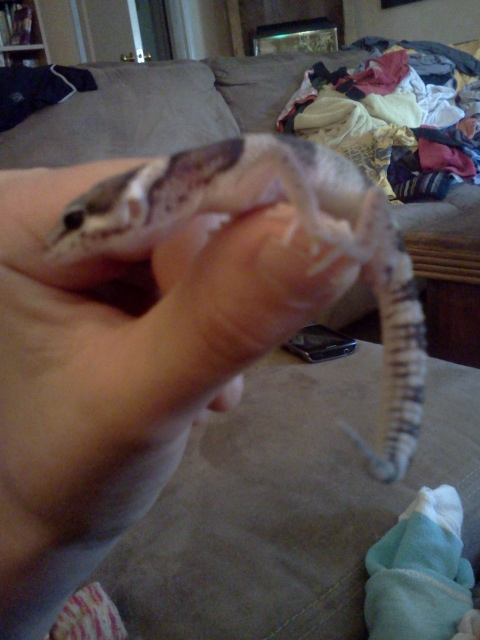 baby leopard gecko morph
Question
Rocky
I just got a super cute baby geck
baby leopard gecko morph
Question
Rocky
I just got a super cute baby geck
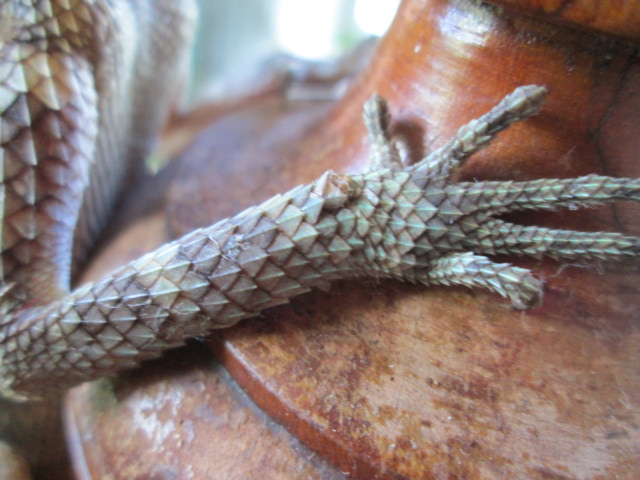 mountain horned dragon twitching
QuestionQUESTION: I recently noticed that my 12 inch BM
mountain horned dragon twitching
QuestionQUESTION: I recently noticed that my 12 inch BM
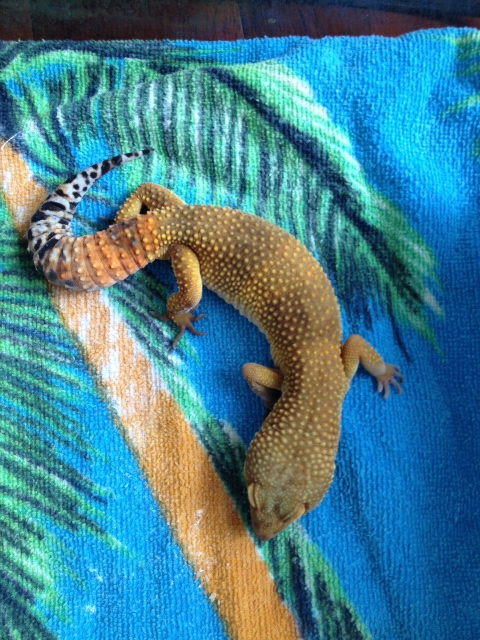 Morph?
Question
Morph Morph
I got a new gecko la
Morph?
Question
Morph Morph
I got a new gecko la
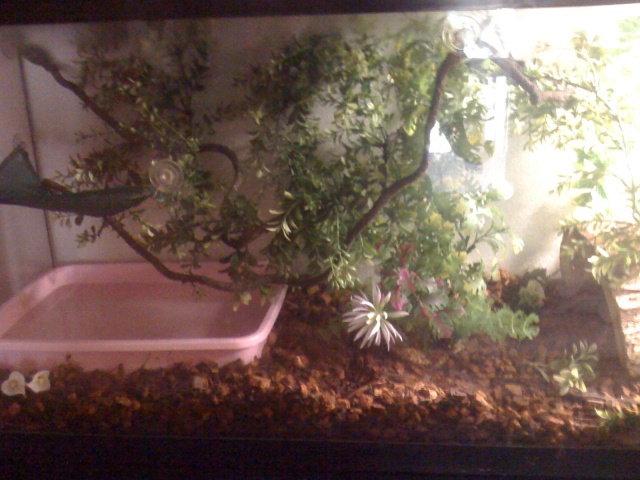 Chinese Water Dragon Not Opening Eyes
QuestionQUESTION: Hello, my name is Morgan and Im an ow
Chinese Water Dragon Not Opening Eyes
QuestionQUESTION: Hello, my name is Morgan and Im an ow
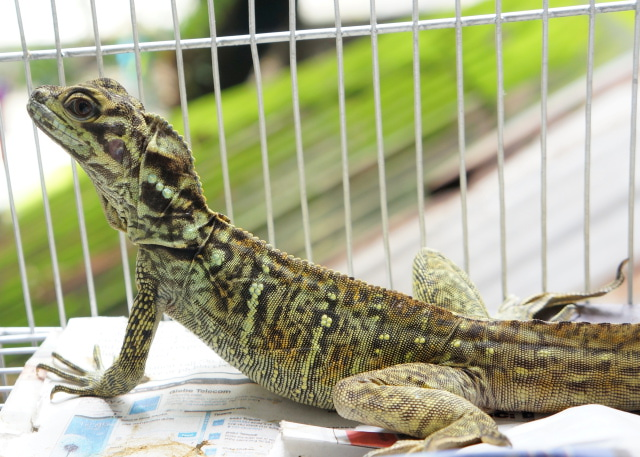 Identifying Sailfin lizard species
QuestionQUESTION: Hello Tracie, Ive been keeping a juve
Identifying Sailfin lizard species
QuestionQUESTION: Hello Tracie, Ive been keeping a juve